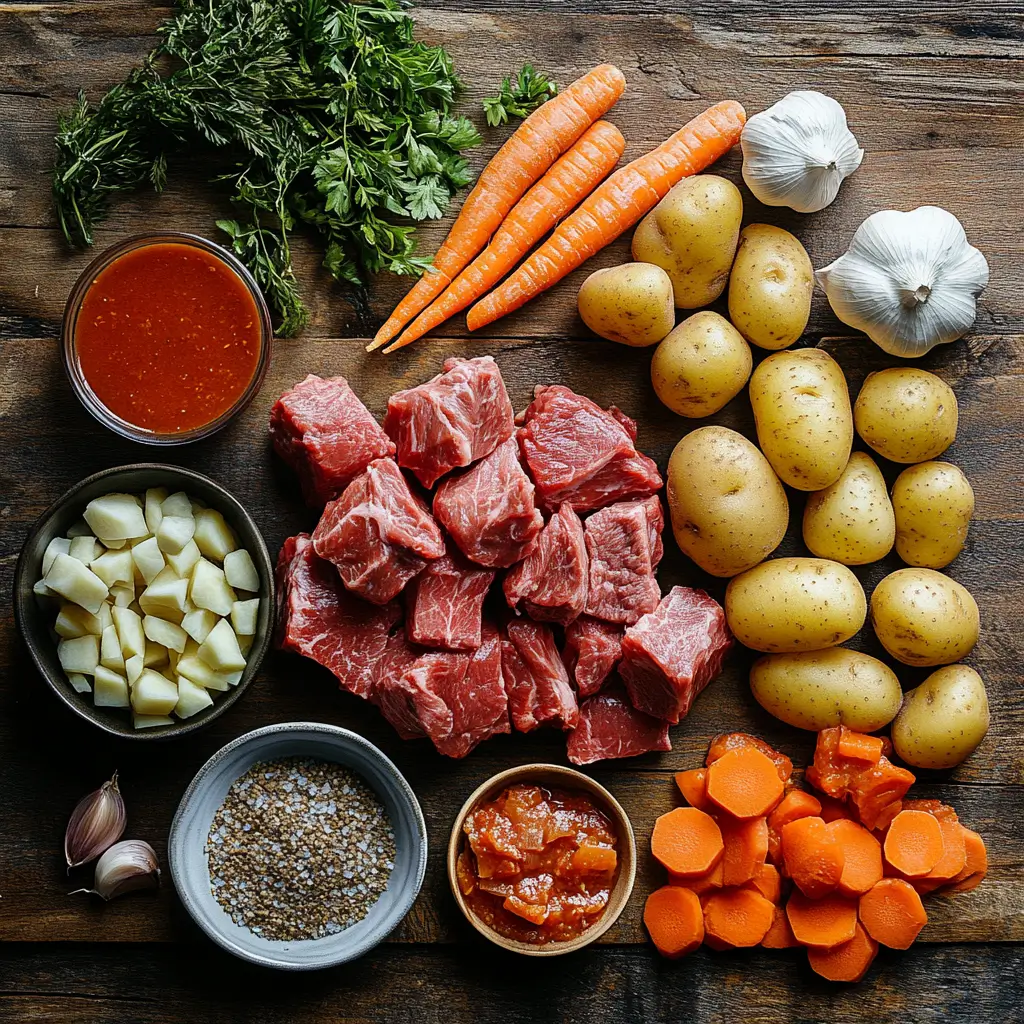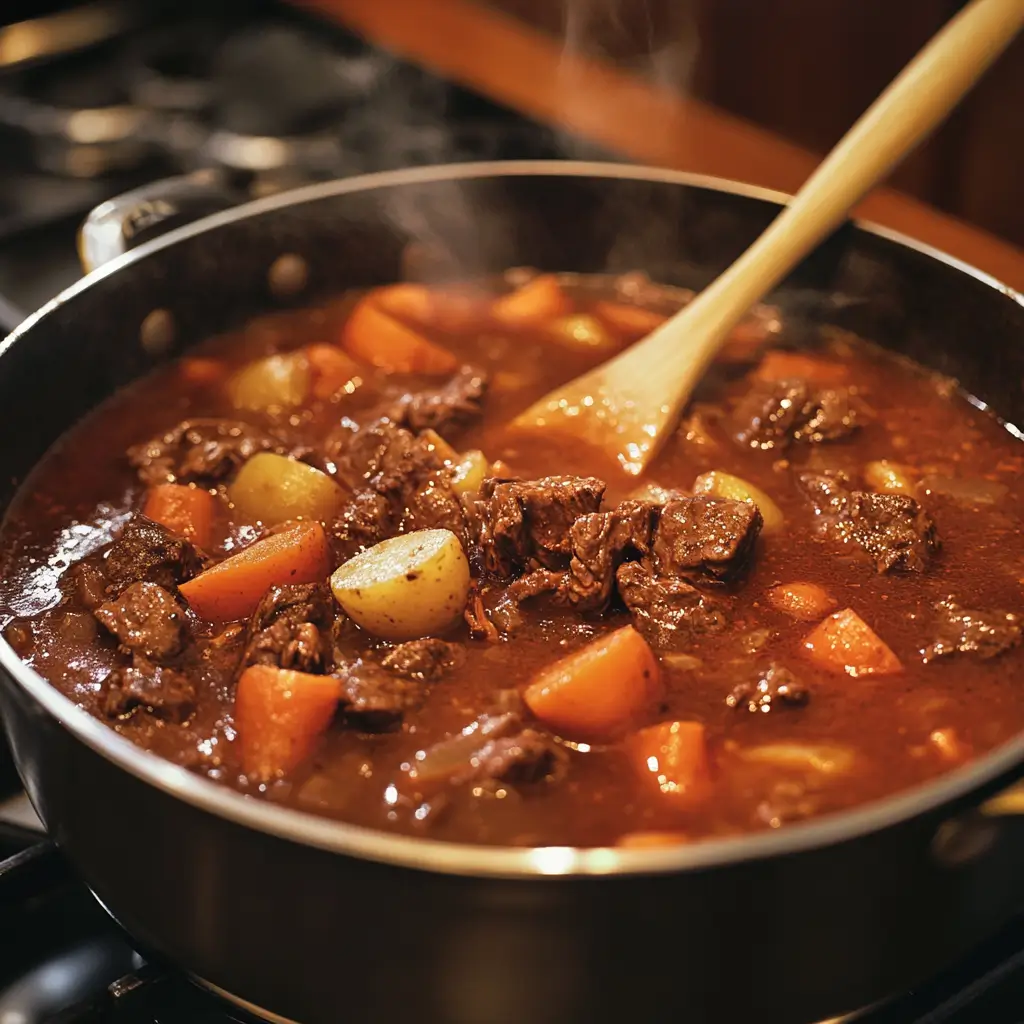Hawaiian beef stew, often called local-style beef stew, is one of the most comforting and beloved dishes in Hawaii. Unlike traditional American or European stews, which rely heavily on beef broth, this dish stands out with its rich, tomato-based broth and bold, slightly sweet undertones. Served over steaming white rice, it embodies the unique blend of cultures that define Hawaiian cuisine.
This recipe has deep roots in the plantation-era history of Hawaii, where immigrants from different countries—especially Portugal, Japan, and the Philippines—brought their cooking techniques and flavors. Over generations, the dish evolved into the iconic comfort food it is today.
We will dive deeper into the best ingredients, essential cooking techniques, and common mistakes to avoid. Whether you’re making it for the first time or perfecting your family recipe, we will help you create the most flavorful, melt-in-your-mouth Hawaiian beef stew possible.
Table of Contents
Why Hawaiian Beef Stew is Different from Other Stews
At first glance, Hawaiian beef stew might look similar to classic beef stew, but key differences make it stand out:
1. The Tomato-Based Broth
Instead of a heavy, brown gravy, this stew features a vibrant, slightly tangy tomato-based broth. The combination of crushed tomatoes and tomato paste creates a deep, rich flavor that enhances the natural sweetness of the carrots and onions.
2. No Thickening Agents
Many stews rely on flour or cornstarch to create a thick consistency, but Hawaiian beef stew does not use any thickeners. Instead, the slow-cooked potatoes naturally break down, helping to create a thicker, heartier texture without the need for added starch.
3. Served Over Rice
Unlike other beef stews that are eaten on their own or with bread, Hawaiian beef stew is always served over rice. The fluffy white rice absorbs the flavorful broth, making every bite incredibly satisfying.
Choosing the Best Ingredients for Hawaiian Beef Stew
Great stew starts with great ingredients. Here’s what you’ll need and why each ingredient plays a crucial role.

1. The Best Cut of Beef for Tender, Juicy Stew
Not all cuts of beef work well for stew. Some become too dry and tough, while others release too much fat into the broth.
The best choices are:
- Chuck roast – The most popular choice because it has the perfect balance of meat, fat, and connective tissue.
- Brisket – Adds deep beefy flavor, but takes a little longer to break down.
- Short ribs – Great for extra richness, as the bones add flavor to the broth.
Pro Tip: Avoid lean cuts like sirloin—they don’t have enough fat and collagen to stay tender during the long cooking process.
2. The Importance of Tomato Paste
Tomato paste is a secret weapon in Hawaiian beef stew. It serves multiple purposes:
- Adds depth and richness – A little goes a long way in creating a deep, robust flavor.
- Thickens the broth naturally – Without needing flour or cornstarch.
- Balances acidity – Helps round out the flavors of the tomatoes.
3. The Role of Hawaiian Sea Salt & Soy Sauce
Most recipes call for just salt and pepper, but Hawaiian beef stew gets its signature umami flavor from a small amount of soy sauce or Hawaiian sea salt.
Hawaiian sea salt is less processed than table salt, with a cleaner, slightly mineral taste. Adding soy sauce deepens the savory notes and enhances the natural sweetness of the vegetables.
Step-by-Step Cooking Instructions for the Perfect Hawaiian Beef Stew
Making Hawaiian beef stew is a slow process, but taking your time ensures the best results. Here’s how to do it:

Step 1: Sear the Beef for Maximum Flavor
Start by heating 2 tablespoons of oil in a large pot over medium-high heat. While the oil heats, cut the beef into large 1.5-2 inch chunks.
Pro Tip: Don’t cut the pieces too small! Larger chunks stay juicy and tender after long cooking.
- Pat the beef dry with a paper towel. Moisture prevents a good sear.
- Season lightly with salt and pepper. This enhances the natural flavors.
- Sear the beef in batches, browning each piece on all sides.
Step 2: Sauté the Aromatics
Once the beef is browned, remove it from the pot and set it aside. In the same pot:
- Add chopped onions, cooking until soft and translucent.
- Stir in minced garlic and ginger. The ginger adds a warm, subtle spice that makes the stew uniquely Hawaiian.
- Cook for 1-2 minutes until fragrant.
Step 3: Build the Tomato-Based Broth
- Stir in 2 tablespoons of tomato paste and cook for 1 minute. This deepens the flavor.
- Pour in one 28-ounce can of crushed tomatoes and mix well.
- Return the seared beef to the pot.
Pro Tip: Deglaze the pot! If anything is stuck to the bottom, scrape it up—those bits add tons of flavor.
Step 4: Simmer for Ultimate Tenderness
- Add 4 cups of water or beef broth.
- Stir in a splash of soy sauce or a pinch of Hawaiian sea salt.
- Bring everything to a gentle simmer, then cover and cook for 1.5 to 2 hours.
Why Low and Slow? Cooking at a low temperature breaks down collagen in the meat, making it incredibly tender.
Step 5: Add Vegetables at the Right Time
After 90 minutes, add:
- Carrots and potatoes – They add sweetness and natural thickness.
- More salt or soy sauce, if needed.
Let everything cook for 30 more minutes, until the vegetables are soft and the beef is fork-tender.
Avoid These Common Mistakes for the Best Hawaiian Beef Stew
Even though Hawaiian beef stew is a simple dish, a few common mistakes can ruin the texture and flavor. Below are key missteps to avoid and how to fix them.
1. Not Searing the Beef Properly
One of the biggest mistakes people make is skipping the searing step or rushing through it. Searing creates a deep, caramelized crust, locking in flavors and enhancing the final dish.
Solution: Always sear beef in small batches over medium-high heat. Let each piece develop a dark golden-brown crust before turning.
2. Adding Vegetables Too Soon
Vegetables like carrots and potatoes break down quickly in hot liquid. If added too early, they turn mushy and lose their shape.
Solution: Add carrots and potatoes in the last 30 minutes of cooking. This ensures they are tender but not overcooked.
3. Cooking at Too High a Temperature
Boiling stew too aggressively toughens the meat and prevents collagen from properly breaking down. Instead of tender beef, you’ll end up with dry, chewy chunks.
Solution: Keep the heat low and steady. A gentle simmer (not a boil) allows the connective tissue to dissolve slowly, resulting in fall-apart tenderness.
4. Underseasoning the Broth
Because tomatoes are naturally acidic, an underseasoned stew may taste too tangy or flat. Many cooks forget to adjust the salt and soy sauce levels during cooking.
Solution: Taste the broth multiple times throughout the cooking process. Add Hawaiian sea salt, soy sauce, or a pinch of sugar as needed to create a perfectly balanced flavor.
Pro Tips for Elevating Your Hawaiian Beef Stew
Now that you know the right techniques, here are some expert tips and creative variations to make your stew even more flavorful and unique.
1. Use Bone-In Beef for a Richer Broth
For an even deeper, more complex flavor, swap some of the beef chuck for bone-in short ribs or oxtail. Bones release natural collagen, which thickens the broth and adds silky richness.
Pro Tip: If using bone-in cuts, extend the cooking time by 30 minutes to allow the extra collagen to fully dissolve.
2. Give It a Hawaiian Kick with Chili Pepper Water
If you enjoy a spicy, island-inspired twist, add Hawaiian chili pepper water. This local vinegar-based hot sauce gives the stew a bright, tangy heat.
Alternative: If you can’t find Hawaiian chili pepper water, substitute a few drops of apple cider vinegar and red pepper flakes.
3. Make It a Slow Cooker or Instant Pot Recipe
Short on time? You can still get amazing results using a slow cooker or pressure cooker.
Slow Cooker Instructions:
- Sear the beef first, then transfer it to a slow cooker.
- Cook on LOW for 8 hours or HIGH for 4 hours.
- Add the vegetables in the last 45 minutes to prevent mushiness.
Instant Pot Instructions:
- Use the Sauté function to brown the beef and cook aromatics.
- Add tomatoes, broth, and seasonings. Cook on HIGH pressure for 35 minutes.
- Let it naturally release for 15 minutes, then stir in vegetables and simmer for another 10 minutes.
Serving and Storing Hawaiian Beef Stew
How to Serve It
Hawaiian beef stew is always served with white rice. The fluffy rice absorbs the rich, tomato-based broth, making each bite deeply satisfying.
For extra freshness, garnish with chopped green onions or a squeeze of fresh lime juice before serving.
How to Store & Reheat Leftovers
Hawaiian beef stew tastes even better the next day, as the flavors continue to develop overnight.
- To store: Keep leftovers in an airtight container in the refrigerator for up to 4 days.
- To freeze: Portion into freezer-safe containers and freeze for up to 3 months.
Reheating Tip: Always reheat low and slow over medium heat, adding a splash of broth or water if needed. Avoid microwaving, as it can cause uneven heating.
FAQs
What is the secret ingredient in beef stew?
Many Hawaiian cooks swear by Hawaiian sea salt and a splash of soy sauce, which enhances the umami flavors in the broth. Some also add a splash of pineapple juice to balance acidity.
Why put tomato paste in beef stew?
Tomato paste is essential because it:
Deepens the flavor, making the stew more robust.
Thickens the broth naturally without needing flour or cornstarch.
Balances acidity, preventing the stew from tasting too tangy.
Which part of beef is best for stew?
The best cuts for Hawaiian beef stew are:
Chuck roast – Tender and flavorful with the right amount of fat.
Brisket – Adds a deep, rich taste but requires longer cooking.
Short ribs – Great for extra tenderness and depth of flavor.
Can I make Hawaiian beef stew in a slow cooker?
Yes! Hawaiian beef stew works perfectly in a slow cooker. Follow these steps:
Brown the beef first, then transfer everything to a slow cooker.
Cook on LOW for 8 hours or HIGH for 4 hours.
Add carrots and potatoes in the last 45 minutes to keep them from overcooking.
How can I make it spicier?
To add a spicy kick, try:
A dash of Hawaiian chili pepper water
A small pinch of red pepper flakes
A few drops of your favorite hot sauce
Conclusion
Hawaiian beef stew is more than just a meal—it’s a taste of the islands, rich with history and bold, comforting flavors. Whether you make it the traditional way or adapt it for a slow cooker or Instant Pot, this dish is guaranteed to bring warmth and nostalgia to your table.
Now that you have the ultimate guide, it’s time to gather your ingredients and start cooking. Enjoy your homemade Hawaiian beef stew, and don’t forget to serve it over a big bowl of rice!
Print
Hawaiian Beef Stew: A Hearty Island Classic with Bold Flavors
- Total Time: 2 hours 15 minutes
- Yield: 1 large pot of stew
Description
Hawaiian beef stew is a comforting, tomato-based dish that stands out from traditional stews with its rich, slightly sweet broth and tender beef. A staple in Hawaii, this dish is often served over rice, making it a deeply satisfying and flavorful meal. With roots tracing back to plantation-era Hawaii, this stew blends diverse culinary influences into one beloved comfort food.
Ingredients
For the Beef:
- 2 lbs chuck roast (or brisket/short ribs), cut into 1.5-2 inch chunks
- 1 teaspoon Hawaiian sea salt (or regular salt)
- ½ teaspoon black pepper
- 2 tablespoons vegetable oil
For the Aromatics & Broth:
- 1 large onion, chopped
- 4 cloves garlic, minced
- 1 tablespoon fresh ginger, minced
- 2 tablespoons tomato paste
- 1 (28-ounce) can crushed tomatoes
- 4 cups water or beef broth
- 1 tablespoon soy sauce (or additional Hawaiian sea salt to taste)
For the Vegetables:
- 3 large carrots, peeled and cut into chunks
- 4 medium potatoes, peeled and cut into chunks
- 1 teaspoon additional salt (or to taste)
For Serving:
- Steamed white rice
Instructions
Sear the Beef:
- Heat 2 tablespoons of oil in a large pot over medium-high heat.
- Pat the beef chunks dry with a paper towel, then season with salt and pepper.
- Sear the beef in batches, browning each piece on all sides. Remove and set aside.
Sauté the Aromatics:
- In the same pot, add chopped onions and cook until soft and translucent.
- Stir in minced garlic and ginger, cooking for 1-2 minutes until fragrant.
Build the Tomato-Based Broth:
- Stir in 2 tablespoons of tomato paste and cook for 1 minute.
- Add the crushed tomatoes and mix well.
- Return the seared beef to the pot and deglaze by scraping any browned bits from the bottom.
Simmer for Tenderness:
- Pour in 4 cups of water or beef broth.
- Add soy sauce (or additional Hawaiian sea salt) for umami depth.
- Bring to a gentle simmer, cover, and cook for 1.5 to 2 hours on low heat.
Add Vegetables:
- After 90 minutes, add the carrots and potatoes.
- Taste and adjust salt if needed.
- Simmer for another 30 minutes until the vegetables are tender and the beef is fork-soft.
Serve:
- Ladle the stew over a bowl of steamed white rice.
- Enjoy this comforting Hawaiian classic!
Notes
- Make Ahead: This stew tastes even better the next day as the flavors deepen overnight.
- Storage: Store in an airtight container in the refrigerator for up to 4 days. Freeze for longer storage.
- Variations: Some families add celery or bell peppers for extra flavor.
- Serving Suggestion: A side of Hawaiian mac salad or lomi-lomi salmon pairs beautifully with this dish.
- Prep Time: 15 minutes
- Cook Time: 2 hours
- Category: Lunch
- Cuisine: Hawaiian
Nutrition
- Calories: ~400
- Fat: 15g
- Carbohydrates: 40g
- Protein: 30g

1 thought on “Hawaiian Beef Stew: A Hearty Island Classic with Bold Flavors”